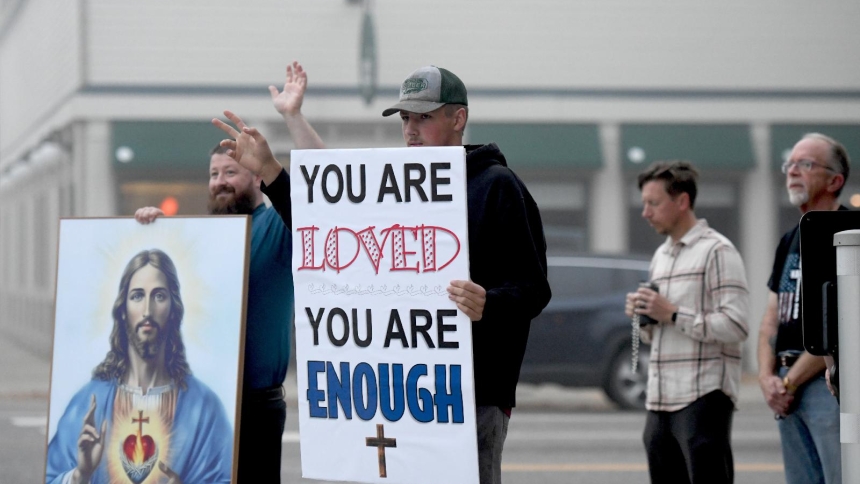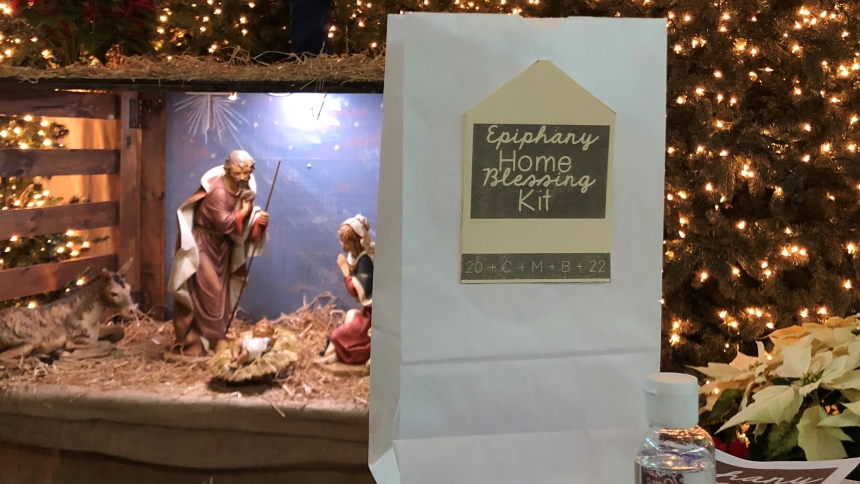
Nota: para la traducción en español, ver abajo
In the summer of 1987, as part of my seminary training, I did a hospital chaplaincy internship in New Orleans. Called Clinical Pastoral Education, the experience is designed to help future priests and ministers to better serve those who are ill and hospitalized, to be more comfortable around sickness and death and to gain deeper insight into how one’s own personality and character shape ministry and engagement with others.
One day, my supervisor asked me to go visit a patient who was not on my floor (he had asked me if I wanted a special challenge to which I said “No, I feel challenged enough already,” but he sent me anyway! Thank the Lord, as it all turned out later). This man, whom I will call Tom, had just suffered the suicide of his only son, a painful divorce from his wife, had just been diagnosed with AIDS as the result of drug abuse and was about to be turned out of the hospital because he had no health insurance.
I had never knowingly met anyone with AIDS. I went in to greet him with much trepidation, as you can imagine. I told Tom who I was and that I was from the Pastoral Care department, to which he responded with curses, swearing and a demand that I leave the room. Not a surprising response, given the situation. I somehow had the presence of mind to ask Tom if I could quietly sit in a chair in the corner for a few moments. I promised not to say anything. He told me to do what I pleased, but in more colorful language than that. I stayed for a minute, silently prayed for Tom and then left. I repeated this for ten days.
On the 11thday, Tom opened up, telling me the whole painful story of his life, filled with a lot of suffering, heartache, addictions and emptiness. As he finished, we were both in tears. Then he asked me, “Do you think God could ever love and forgive me?” Without thinking about it, I hugged Tom, assuring him that God had never stopped loving him and that forgiveness was always possible. He told me later that it was the first time that someone had touched him without gloves since he had been diagnosed with AIDS. In that encounter, the risen Lord touched both of us, a nervous seminarian and a broken, suffering man, bringing healing and peace.
I always think of that powerful experience on the Second Sunday of Easter when the Gospel of doubting Thomas is proclaimed. In John’s narrative, Thomas comes to faith by touching the wounds of the risen Christ, probing the nail marks and putting his hand into Jesus’ wounded side. He comes to know that this mysterious and luminous figure in front of him is the same Jesus he knew in the flesh and who died on the cross.
I often wondered why Jesus’ wounds stubbornly remained after the resurrection. After all, the mighty divine power that raised Jesus from the dead could certainly heal a few nail holes and a spear gash. Maybe the wounds stay to teach us that the victory of Easter Sunday doesn’t completely obliterate the suffering of Good Friday, that even though Jesus has gained the victory over sin and death, we will still encounter suffering and darkness in this life, and that the story isn’t quite finished, even though we know how it turns out in the end.
But now, through the power of the resurrection, Jesus’ wounds become trophies of victory, transformed into founts of mercy, healing, forgiveness and love. Thomas comes to faith by touching them and so do we. We touch the wounds of the risen Lord every time we serve the poor, visit the sick, console the troubled, listen to a child or reach out in love to a stranger. This truth is the great secret of the saints!
When Vincent de Paul, Mother Teresa, Camillus de Lellis, Louise de Marillac and John of God loved the poor and served the distressed, they knew they were touching the very wounds of Christ! We are called to enter into the terrible suffering of this world with the light of Christ, to courageously love the most neglected and marginalized and to unleash the powerful mercy of the Risen Christ by pouring ourselves out in service to others.
The Lord touched and healed me 28 years ago in a Louisiana hospital room, through a broken man who has been long dead, by inviting me to probe the nail holes and put my hand into His sacred side. I have never been fully the same since, for I was touched by the fire of the Divine Mercy.
+ Donald J. Hying
A través de la resurrección, las heridas de Jesús se convierten en trofeos de la victoria
En el verano de 1987, como parte de mi formación de seminario, hice una pasantía de capellanía de hospital en Nueva Orleans. Llamado Educación Pastoral Clínica, la experiencia está diseñada para ayudar a futuros sacerdotes y ministros para servir mejor a aquellos que están enfermos y hospitalizados, a estar más cómodo con la enfermedad y la muerte y para profundizar más en cómo su propia personalidad y carácter forma ministerio y el compromiso con los demás.
Un día, mi supervisor me preguntó a visitar a un paciente que no estaba en mi piso (me pidió si quería un desafío especial a la cual le dije "No, me siento desafiado ya es suficiente," pero de todos modos me envió! Gracias a Dios, como todo resultado más adelante). Este hombre, a quien llamo a Tom, sólo había sufrido el suicidio de su único hijo, un doloroso divorcio de su esposa, sólo había sido diagnosticado con SIDA como resultado del abuso de drogas y estuvo a punto de dar vuelta fuera del hospital porque no tenía ningún seguro de salud.
Conscientemente nunca había conocido a alguien con SIDA. Fui a saludarlo con mucha ansiedad, como pueden imaginar. Le dije a Tom quien yo era y que era del Departamento de Pastoral de la Salud, a lo que respondió con maldiciones, insultos y una demanda que deje la habitación. No una respuesta sorprendente, dada la situación. De alguna manera tenía la presencia de la mente a Tom si tranquilamente podría sentarme en una silla en la esquina por unos momentos. Prometí no quiere decir nada. Le dijo que hiciera lo que quisiera, pero en un lenguaje colorido más que eso. Me quedé un minuto, oró en silencio por Tom y luego salí. Esto lo repetí durante diez días.
En la 11ºjornada, Tom comenzó a hablar, diciéndome la historia entera dolorosa de su vida, llenado de un montón de sufrimiento, angustia, adicciones y vacío. Como terminó, ambos estábamos en lágrimas. Entonces me preguntó: "¿Crees que Dios nunca podría amar y perdonarme?" Sin pensarlo, abracé a Tom, asegurándole que Dios nunca había dejado de amarlo y que siempre era posible perdón. Más tarde me dijo que era la primera vez que alguien había tocado sin guantes ya que había sido diagnosticado con SIDA. En ese encuentro, el Señor resucitado tocaba a los dos de nosotros, un seminarista nervioso y un roto, sufriendo hombre, trayendo la sanación y la paz.
Siempre pienso que la experiencia de gran alcance en el segundo domingo de Pascua cuando se proclama el Evangelio de Tomás incrédulo. En la narrativa de Juan, Tomás viene a fe por tocar las heridas de Cristo resucitado, sondeando las marcas de uñas y poniendo su mano en el costado herido de Jesús. Viene a esta figura misteriosa y luminosa delante de él es el mismo Jesús sabía en carne y hueso y que murió en la cruz.
A menudo me preguntaba por qué las heridas de Jesús permanecieron obstinadamente después de la resurrección. Después de todo, el poderoso divino poder que resucitó a Jesús de entre los muertos sin duda podría sanar unos agujeros de clavos y una herida de lanza. Tal vez las heridas se quedan para enseñarnos que la victoria del domingo de Pascua no borra completamente el sufrimiento del Viernes Bueno, que a pesar de que Jesús ha ganado la victoria sobre el pecado y la muerte, todavía encontramos el sufrimiento y oscuridad en esta vida, y que la historia no está terminado, aunque sabemos cómo resulta al final.
Pero ahora, a través del poder de la resurrección, las heridas de Jesús se convierten en trofeos de la victoria, transformado en fuentes de misericordia, curación, el perdón y el amor. Thomas viene a fe tocándolas y nosotros. Tocamos las heridas del Señor resucitado cada vez que servimos a los pobres, visitamos a los enfermos, consolamos a los atribulados, escuchamos a un niño o alcanzamos en amor con un desconocido. ¡Esta verdad es el gran secreto de los santos!
Cuando Vicente de Paul, la Madre Teresa, Camillus de Lellis, Louisa de Marillac y Juan de Dios amaron a los pobres y sirvieron a vlos afligidos, sabían que estaban tocando las heridas de Cristo misma. Estamos llamados a entrar en el terrible sufrimiento de este mundo con la luz de Cristo, a amar con valentía las más olvidadas y marginadas y dar rienda suelta a la poderosa misericordia de Cristo resucitado por nosotros mismos entrando en servicio a los demás.
El Señor tocó y me curó hace 28 años en una habitación de hospital de Louisiana, a través de un hombre roto que ha muerto, por invitarme a sondear los orificios y poner mi mano en su costado sagrado. Nunca estuve completamente el mismo, porque me conmovió el fuego de la Divina Misericordia.
+ Donald J. Hying


